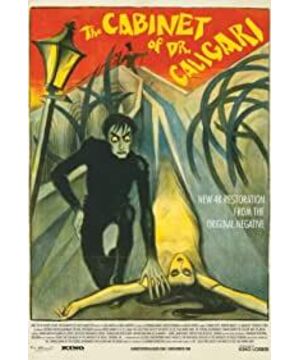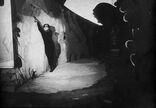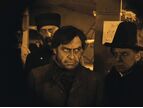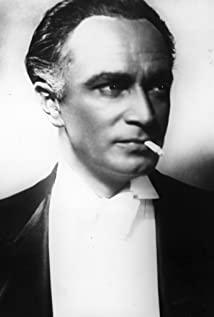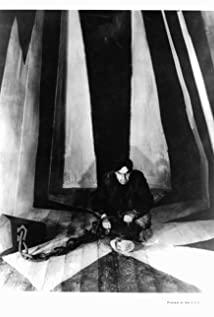Expressionism was originally a dedicated term for art history and criticism, meaning that it no longer regards nature as the primary purpose of art, and expressing emotions and feelings with lines, shapes and colors as the sole purpose of art. Expressionist films originated in Germany in 1920. The actors, objects, and set designs in such films are all used to convey emotions and mental states, and do not pay attention to the original meaning of objects. "Dr. Caligari's Cabin" (1919) is famous for using this technique. Later, the style of German expressionism influenced some Hollywood films in the silent era and noir films in the 1940s, others such as Hitchcock and Orson. Wells was also influenced by expressionism.
Expressionism in a broad sense refers to any art that expresses inner emotions. It is irrational and subjective. It mainly appeared in the early 20th century, especially during the period of social turmoil, and expressed a kind of horrible emotion.
Caligari was filmed in 1919, shortly after the end of the First World War.
The defeat on the battlefield exacerbated the political crisis within Germany. The war caused great economic damage. A large number of peasants enlisted in the army, resulting in barren land and rising prices. Many people died of starvation. The Treaty of Versailles, which Germany was forced to sign on January 18, 1919, was a very harsh treaty imposed on Germany by the victorious country. Many Germans took to the streets to demonstrate against the "Versailles Peace Treaty." After the war, nationalism and revengeism spread in Germany.
"Art comes from life and is higher than life" should be an interpretation of Caligali-World War I was devastating for Germany.
The characters' contrasting makeup, exaggerated performances, neurotic and confused appearances in the film reflect the mental outlook and psychological state of the Germans at that time. The twisted and crooked doors in the film, the hideous bare branches, the little monkey dolls in the market, the exaggerated chairs, the round pupils, the labyrinth-like town... are all portrayals of the spiritual world of the Germans at that time, disappointed, Lost, dark, low...
Through the protagonist's mouth, a miniature of a dark and weird small town appeared in front of us, and melancholy blue shrouded the slanted house.
Caligali is sketched out with the old memories, and everyone can observe the background-the color change of the town, which highlights Caligali's gloom.
The picture is cut out geometrically, all the furniture is abstract, the windows are also slanted, depicting a kind of panic before the horror comes, we can also find the same way of expression in Picasso's paintings.
The streets of the town are simple outlines of geometric shapes.
The house is completely skewed, and the irregular explosive patterns on the road echo the background of the subtitles. This sharp pattern vaguely expresses a terrifying and dark atmosphere.
This is Caligari’s cabin, an abstract expression.
The scenes of the small town were basically drawn by the set designers Herman Valm, Walter Rorich, and Walter Lehman. The river in the distance can be called hurricane, without details. , There is only a visual impact.
The aisle was painted like an illusion.
When the heroine appears, we can see some soft patterns. The chairs and tables in the picture are completely exaggerated. The round lights in the room are also very exaggerated, and the shadows they cast are also exaggerated, but they just echo the background and show the soft beauty of women. From this we can see the elaborate design of the set designer.
The market in the small town looks dreamy. The spires and triangular patterns of the houses can reflect the heroine's heart-nervousness and worry.
The composition of the film is beautiful, geometric and gloomy. In this movie, there is no real scene, which is characteristic of early expressionist movies.
It is still a sharp geometric shape. The film handles shadows very well. Light and shadow are also the biggest characteristics of expressionist films. No expressionist film does not carefully create the dreamy effect of changing light and shadow.
This scene is even more exaggerated and abstract, and the long and narrow door seems to represent the concentration of authority. The holders of power in the film are all sitting on extremely high stools, which should also be a symbol of power.
The scene of the mental hospital is also very dreamy.
The film also does a different treatment on the appearance of morbid characters. Caligali is a crazy image, while the image of Shezar, a sleepwalker, is frightening. The final appearance of the heroine Jane is also different from the previous makeup.
But this unique film tells the audience the true truth at the prologue and at the end-the perverted world, and the crazy story, which is actually the world in the eyes of the lunatics who were imprisoned by Dr. Caligali in the lunatic asylum. As a result, Dr. Caligari became a symbol of authority and despotism, and the film became a propaganda film for maintaining authority. The subconscious of the lunatics also secretly condemned Caligali's "tyrant image."
In fact, the film is negative, with a negative attitude towards authority and authoritarianism, but its disguise guarantees the film’s popularity at the time. The historical background of Germany just shows the birth of the film and the art form of the film. Therefore, some people say that this is a film describing the mental state, especially the mental state of the German people at that time.
"Dr. Caligari's Cabin" expresses the trance, anxiety and fear of people in reality through the setting and character performances. The distortion and abstraction of the reality of the setting emphasizes the expression of the emotion of fear. Obviously, the author is dissatisfied with the status quo of society. The film pursues subjective spirit and inner passion, which can also be seen from the set. This is an avant-garde movie, the first to create an absurd and bizarre plot, there is no clear boundary between fantasy and reality. Rebellion is the main voice of expressionism, and reforming society is often their voice.
The aesthetic foundation of the film is based on what Herman Valm once said-the film should become a living painting, pursuing a sense of strength and rhythm, and the performance of the characters is like the same frame of flash.
The Nazis once referred to this film as "degenerate art", while Einstein referred to it as "the savage carnival of mankind."
View more about The Cabinet of Dr. Caligari reviews


